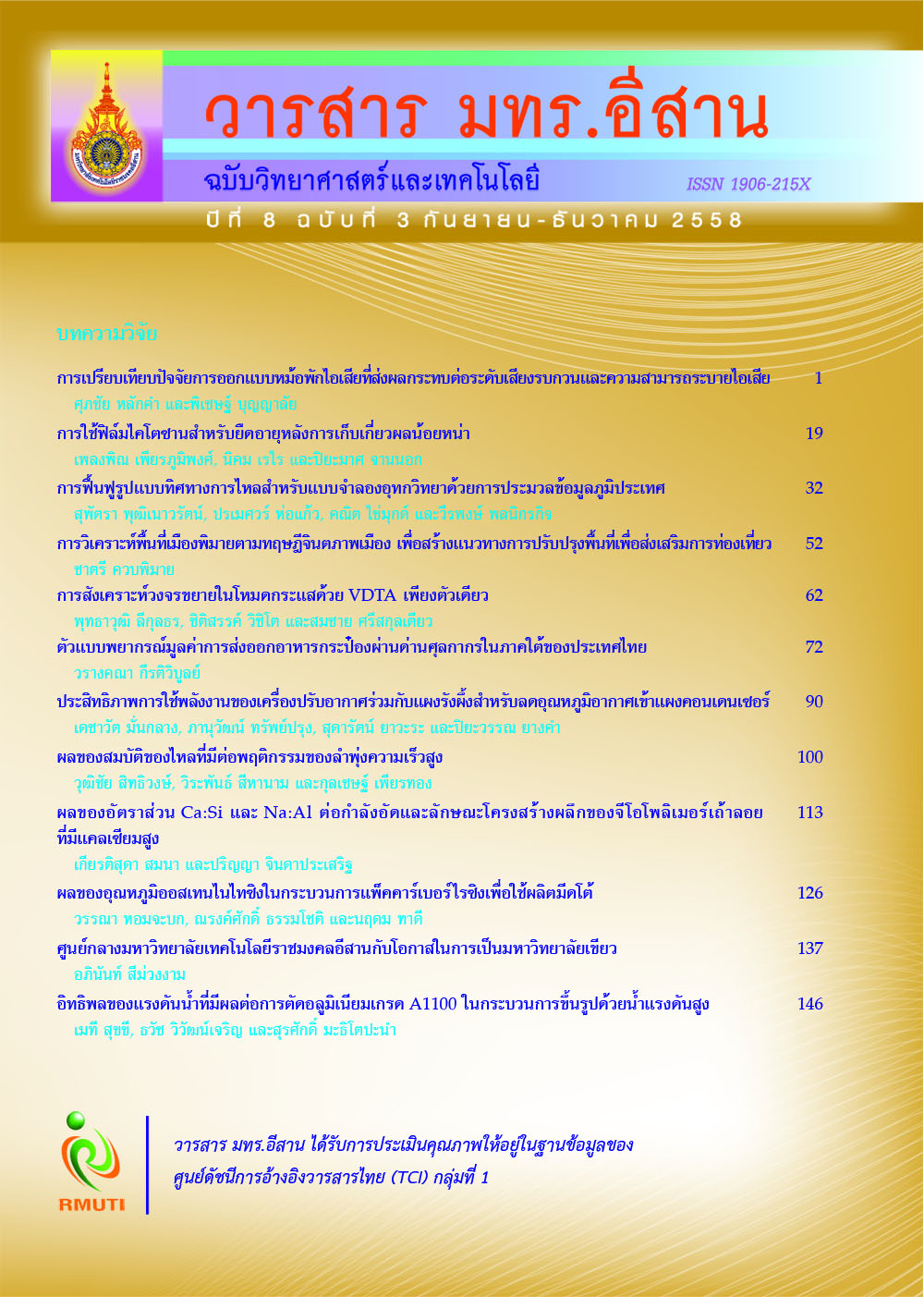การใช้ฟิล์มไคโตซานสำหรับยืดอายุหลังการเก็บเกี่ยวผลน้อยหน่า Application of Edible Chitosan Film for Post-Harvest Shelf Life of Annana Squamosal Linn. Petch Pakchong Variety
Main Article Content
Abstract
บทคัดย่อ
งานวิจัยมีวัตถุประสงค์เพื่อประเมินประสิทธิภาพของฟิล์มจากไคโตซานในการยืดอายุการเก็บรักษา
ผลน้อยหน่า การทดลองนำน้อยหน่าพันธุ์เพชรปากช่องที่มีขนาด สี รูปร่าง นํ้าหนัก ที่ใกล้เคียงกัน
ไม่มีตำหนิ ไม่พบการเข้าทำลายของเชื้อโรคมาห่อหุ้มด้วยฟิล์มที่ผลิตจากไคโตซานที่มีความเข้มข้น 3 ระดับ
คือ 1.0 1.5 และ 2.0 เปอร์เซ็นต์ และนำผลน้อยหน่าเก็บรักษาไว้ที่อุณหภูมิ 16 องศาเซลเซียส
ผลการทดลองพบว่า ชุดที่ห่อหุ้มด้วยไคโตซานทุกความเข้มข้นสามารถยืดอายุการเก็บรักษา ลดการสูญเสีย
นํ้าหนัก ชะลอการเปลี่ยนแปลงสีของเปลือกน้อยหน่า ชะลอการเกิดสีนํ้าตาล ชะลอการเปลี่ยนแปลง
ความแน่นเนื้อ เพิ่มปริมาณของแข็งทั้งหมดที่ละลายนํ้าได้ และปริมาณกรดทั้งหมดที่ไตรเตรทได้
นอกจากนี้เมื่อเปรียบเทียบระหว่างความเข้มข้นที่ต่างกัน พบว่าชุดที่ห่อหุ้มด้วยไคโตซานความเข้มข้น
2 เปอร์เซ็นต์ สามารถรักษาคุณภาพระหว่างการเก็บรักษาของน้อยหน่าพันธุ์เพชรปากช่องได้ดีที่สุด
ดังนั้นการประยุกต์ใช้ฟิล์มผลิตจากไคโตซานในการห่อหุ้มผิวน้อยหน่าพันธุ์เพชรปากช่องแทนการใช้
กระดาษจึงเป็นอีกทางหนึ่งในการรักษาคุณภาพของผลน้อยหน่า อีกทั้งช่วยยืดอายุผลน้อยหน่าในระหว่าง
การเก็บรักษาและการขนส่งอีกด้วย
Abstract
The aim of research was to evaluate the efficiency of edible chitosan films for
post-harvest shelf life of Annana Squamosal Linn. Petch Pakchong Variety. The edible
films were produced from three different chitosan concentrations including 1.0, 1.5
and 2.0 percentage. All fruits which had the same color, shape, weight, uniform size
and absence of any physical damage and fungal infection were individually wrapped
with edible chitosan film and stored at 16oC. The results were shown that edible
chitosan films could extend shelf life of fruits by decreased weight loss, delay changes
in color of peels and firmness, and increased total soluble solids (TSS) and titratable
acidity (TA). In addition, the 2 percentage chitosan film was effective than 1.0 and
1.5 percentage chitosan. In conclude, the application of chitosan film could be an
alternative method by extending shelf life of Annona squamosa Linn. Petch Pakchong
variety during storage and transportation
Article Details
References
Oumsomniang, Y. (2005). Growth and development, harvesting indices, and effects of
plastic film wrap and low temperature on quality and storage life of atemoya
fruits (Annona atemoya Hort. cv. Petpakchong). Thesis, Crop production
technology. Suranaree University of Technology. p. 118
Pangma, W. (2006). Effect of edible coating and modified atmosphere packaging on
pericarp browning of longkong. Thesis, Postharvest Technology. Faculty of
School of Bioresources and Technology. King Mongkut’s University of
Technology Thonburi. p. 110
Paull, R. E. and Rohrbach, K. G. (1985). Symptom development of chilling injury in
pineapple. Journal of the American Society for Horticultural Science. Vol. 110.
No. 1. pp. 100-105
Vickery, L. M. and Brain, V. (1981). Secondary plant metabolism. The Macmillan Press Ltd.,
London. p. 335
Wills, R. B. H., Lee, T. H., Graham, D., Mcglasson, W. B. and Hall, E. G. (1981). Postharvest
and introduction to the physiology and handling of fruit and vegetables,
New South Wales. New South Wales University Press. p. 161


